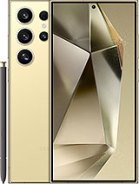With the recent global release of the Xiaomi 14 Ultra, camera enthusiasts have another option to consider. The Xiaomi, known for its camera excellence, has made tangible improvements in its telephoto capabilities.
The latest Samsung Galaxy S24 Ultra has also made significant changes in its zoom capabilities by replacing the old model’s 10x zoom unit with a larger-sensor 5x one. This makes a comparison between the Xiaomi and Samsung more natural.
The Galaxy S24 Ultra is possibly one of the most advanced smartphones available, so the Xiaomi needs to offer more than just exceptional picture quality to compete. Let’s see how it measures up.
Size comparison
Both phones are large but have different approaches to size, proportions, and styling. The Xiaomi has more fluid shapes, rounded corners, a curved display, and a frame that flows into the back to mask its size. The Galaxy, on the other hand, has a more angular and flat design that emphasizes its size and weight.

Both handsets are IP68 rated for dust and water resistance, but neither surpasses the IPX8 standard requirements. Samsung uses a titanium exposed frame, while Xiaomi uses aluminum. Samsung also uses Corning’s Gorilla Armor for durability. Xiaomi uses Xiaomi Shield Glass for better drop resistance.
Each phone has a unique accessory – the Galaxy comes with an S Pen, while Xiaomi offers the Photography Kit as an optional add-on for an extra cost.

Display comparison
Both phones offer high-resolution and high-refresh-rate displays with ample brightness. While the Galaxy has a brighter display, the Xiaomi’s display has less reflectivity due to its glass material.
Battery life
Both phones have 5,000mAh batteries, but the Xiaomi is less efficient in converting capacity into longevity compared to the Galaxy. The Galaxy offers better battery life in various scenarios like web browsing, gaming, and video playback.
Charging speed
The Xiaomi charges almost twice as fast as the Galaxy, with impressive charging speeds both wired and wirelessly. The Galaxy, on the other hand, has a slower charging speed but offers wireless charging up to 15W.
Both phones also have the capability to charge other devices wirelessly or through a cable.
Speaker test
Both phones feature stereo speaker setups, with slight differences in implementation. In our testing, both phones rated ‘Very Good’ for loudness, but the Galaxy has a slightly better midrange and bass.
Performance
Both phones are powered by the Snapdragon 8 Gen 3 chipset. The Galaxy offers more storage options and RAM configurations compared to the Xiaomi.
Benchmark performance
Benchmark performance is similar between the two phones, with high numbers and no underperformance.
While the Xiaomi handles sustained load better, the Galaxy has advantages in software and updates, offering longer OS support and collaboration with Google for AI features.
The Galaxy’s S Pen offers unique functionality, while Xiaomi’s Photography Kit enhances the camera experience further.
Camera comparison
Both phones have advanced cameras, with the Xiaomi excelling in close-up shots and the Galaxy offering superior selfies. The Xiaomi features the Photography Kit as an optional accessory.
Xiaomi 14 Ultra camera specs
- Wide (main): 50MP Sony LYT-900 (1″, 1.6µm – 3.2µm), f/1.63-f/4.0, 23mm, PDAF, OIS; 4K@120fps
- Ultrawide: 50MP Sony IMX858 (1/2.51″, 0.7µm-1.4µm), f/1.8, 12mm, PDAF; 4K@60fps
- Telephoto 1, 3.2x: 50MP Sony IMX858 (1/2.51″, 0.7µm-1.4µm), f/1.8, 75mm, PDAF, OIS; 4K@60fps
- Telephoto 1, 5x: 50MP Sony IMX858 (1/2.51″, 0.7µm-1.4µm), f/1.8, 120mm, PDAF, OIS; 4K@60fps
- Front camera: 32MP OmniVision OV32B40 (1/3.14″, 0.7µm-1.4µm), f/2.0, 22mm, fixed focus; 4K@60fps
Samsung Galaxy S24 Ultra camera specs
- Wide (main): 200MP Samsung ISOCELL HP2 (1/1.3″, 0.6µm-2.4µm), f/1.7, 23mm, PDAF, OIS; 8K@30fps, 4K@120fps
- Ultrawide: 12MP Sony IMX563 (1/2.55″, 1.4µm), f/2.2, PDAF; 4K@60fps
- Telephoto 1, 3x: 12MP Sony IMX754 (1/3.52″, 1.12µm), f/2.2, 67mm, PDAF, OIS; 4K@60fps
- Telephoto 2, 5x: 50MP Sony IMX854 (1/2.52″, 0.7-1.4µm), f/3.4, 111mm, PDAF, OIS; 4K@60fps
- Front camera: 12MP Samsung ISOCELL S5K3LU (1/3.2″, 1.12µm), f/2.2, 26mm, PDAF; 4K@60fps
Image quality
The two phones produce similar results in terms of sharpness, detail, and color rendition. There are slight differences in contrast and saturation, but both offer excellent image quality.
In low light, both phones perform well with little difference in quality. The Xiaomi is slightly smoother in shots, while the Galaxy offers more grain for better detail.
Video quality
Both phones offer high-quality video recording capabilities with little difference in performance. The Galaxy has the edge in low-light video quality, while the Xiaomi excels in telephoto footage.
Verdict
Choosing between the Xiaomi 14 Ultra and Samsung Galaxy S24 Ultra isn’t solely based on camera performance. Both phones offer exceptional imaging capabilities, with unique strengths in different areas. The Galaxy S24 Ultra offers a more well-rounded package with features like the S Pen, longer battery life, and software support. The Xiaomi 14 Ultra stands out for its charging speed, thermal handling, and optional Photography Kit.
Ultimately, the choice between the two will depend on individual preferences and priorities. The Samsung Galaxy S24 Ultra offers a more versatile and value-for-money option, while the Xiaomi 14 Ultra provides an enticing camera experience with additional accessories.

Get the Xiaomi 14 Ultra for:
- Best camera system
- Superior close-up shots
- Photography Kit
- Fast charging
- Improved thermal handling

Get the Samsung Galaxy S24 Ultra for:
- Best camera system
- Excellent selfies
- S Pen functionality
- Long battery life
- One UI and updates
Source: GSMArena
